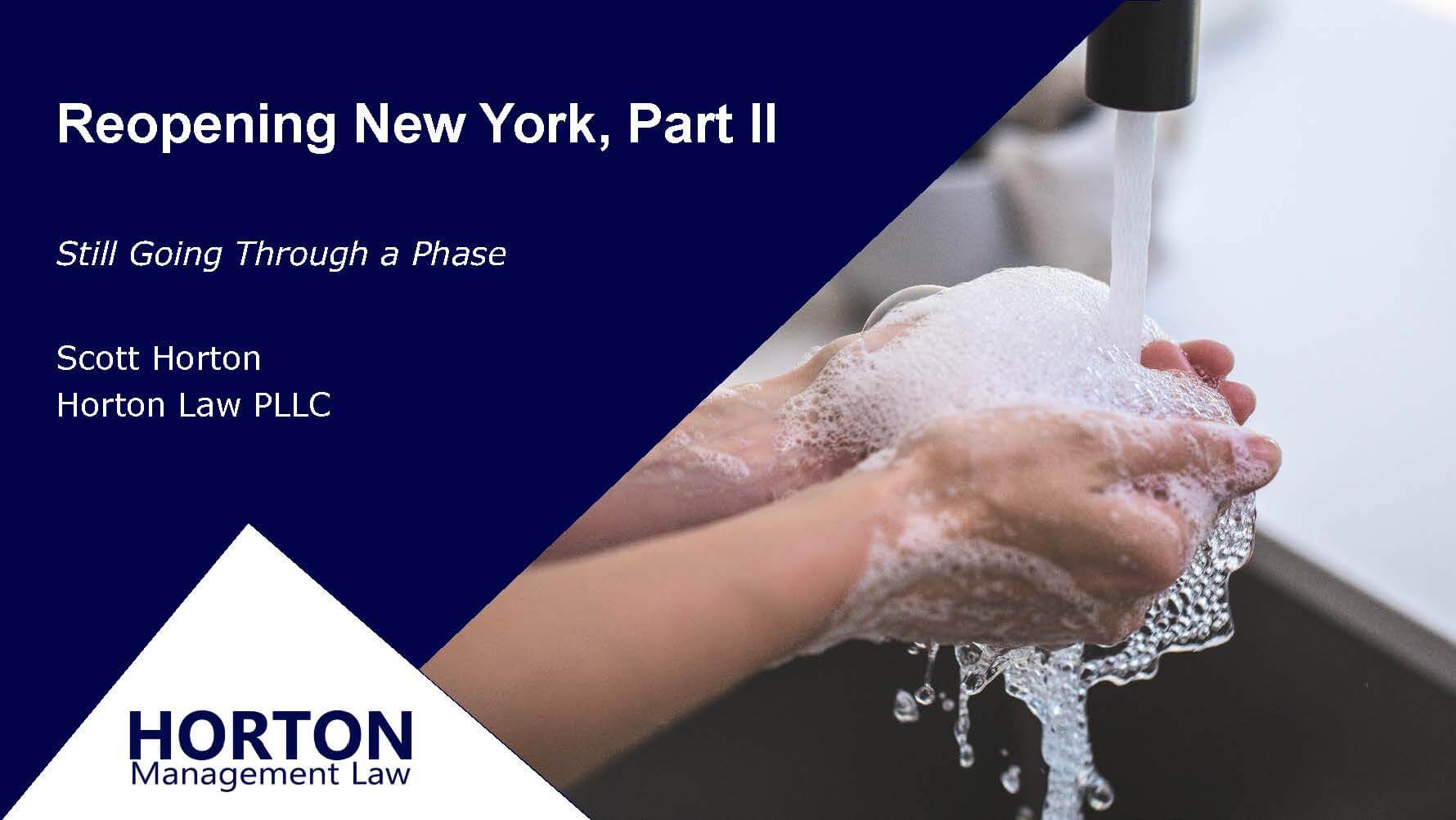Phase 2 of New York’s reopening plan includes separate guidelines for offices and commercial building management. Where different entities own and operate portions of a commercial building, multiple parties have obligations related to keeping people safe within the building.
The industry-specific guidelines have been divided into five categories: Physical Distancing; Protective Equipment; Hygiene and Cleaning; Communication; and Screening. Summary Guidelines for these industry groups include both Mandatory and Recommended Best Practices. The office and commercial building management guidelines also indicate that businesses must follow other CDC and Department of Health recommendations that will assist in protecting employees and customers and prevent the spread of the coronavirus.
Office-Based Work
Companies whose core functions are performed in an office environment may reopen in Phase 2. But to do so, they must implement the mandatory requirements outlined in the NYS guidelines. These include businesses previously operating as essential businesses that fall into the office-based work category.
Office-based work typically includes these categories, as well as an office location that performs similar functions for a company even if it falls into another industry category:
- Professional Services
- Non-Profit
- Technology
- Administrative Support
- Higher Education Administration (excluding full campus reopening)
NYS Summary Guidelines
NYS Detailed Guidelines
Commercial Building Management
This category covers all commercial and non-residential buildings in regions that have been permitted to reopen offices, including those that were previously operating as essential businesses. Since most commercial buildings have other industries operating within them, the guidelines for this business sector add to the requirements placed on a physical location overall. Thus, where one party owns the building and another or multiple others operate within it, several businesses may need to work together to satisfy the combined requirements for reopening offices.
NYS Summary Guidelines
NYS Detailed Guidelines
Physical Distancing Requirements
The mandatory health and safety guidelines address the physical distancing requirements for commercial building management and locations performing office-based work. Offices are restricted to no more than 50% of the maximum occupancy for the location, as set forth by the certificate of occupancy.
Individuals must stay at least 6 feet from each other at all times unless the core activity requires a shorter distance. If people must come within 6 feet of each other, they must wear proper face coverings.
Social distancing markers must be posted in all commonly used and other areas within the office where individuals may gather (e.g., health screening stations, clock-in/clock-out stations, or restrooms located within the office). Commercial Building Managers will be responsible for posting social distancing markers in any common areas throughout the building (e.g., restroom, elevator, lobby, health screening stations).
The use of confined spaces should be restricted to only one person at a time, unless all individuals are wearing proper face coverings. Even when utilizing suitable face coverings, no more than 50% of maximum occupancy will be permitted (e.g., elevators, restrooms). All non-essential common areas in the building and individual offices should be closed.
In-person gatherings must be limited to the extent possible. The guidelines encourage the use of tele- or videoconferencing. Shared workspaces should be eliminated or reduced to the extent possible. At a minimum, shared workspaces must be cleaned and disinfected between each use.
Employers in office-based environments should take advantage of alternate means to reduce interpersonal contact and congregations. Possibilities include adjusting workplace hours, only requiring essential staff to report to the office, modifications to employee shifts and office design, or changes to arrival and departure times.
Additional Physical Distance Requirements
Commercial building managers have some additional responsibilities. They must educate tenants on maximum occupancy limits for all rented or leased space and monitor compliance with the restrictions. They must inform tenants of social distancing requirements and of the need for wearing proper face coverings whenever a 6-foot distance from other individuals is not feasible. Depending on the terms of the lease agreement, building managers might be responsible for making physical altercations to the office space to allow for compliance with these requirements.
Protective Equipment Guidelines
Commercial building managers and employers overseeing locations with office-based work must provide employees with acceptable face coverings. They must provide masks at no cost to the employee and ensure that there is an adequate supply. They must educate employees on how to correctly put on, take off, and discard the face coverings.
Workers should avoid the sharing of objects, equipment, or workspaces whenever possible. These include items such as tools, laptops, touchscreens, printers, and writing utensils. Employers can either require workers that share objects and equipment to wear disposable gloves, provided at no cost by the employer, or clean and disinfect shared equipment between each use and provide employees with proper hand hygiene stations.
Additional Physical Equipment Guidelines
Commercial building managers will likely need to install physical barriers in any location where employees interact with the public, such as reception and security desks. OSHA recommends this measure.
Hygiene and Cleaning Guidelines
Commercial building managers and companies performing office-based work must adhere to the hygiene and sanitation requirements set forth by the Centers for Disease Control and Prevention (CDC) and the Department of Health (DOH). These protocols include providing and maintaining proper hand hygiene stations throughout the building. Hand hygiene stations include soap, running water, and disposable paper towels, as well as an alcohol-based hand sanitizer containing 60% or more alcohol for areas where handwashing is not feasible.
Offices must be adequately cleaned and disinfected using registered disinfectants, at least as often as employees and contractors change work stations. Commonly used or high-risk areas should be cleaned and disinfected even more frequently. Employers are responsible for conducting rigorous cleaning and disinfection at least after each shift, daily or more often.
Companies must establish procedures to follow for confirmed COVID-19 cases. These should cover the cleaning and disinfecting of the individual’s worksite and the surrounding area, all heavy transit areas, and high-touch areas (e.g., such as elevators, lobbies, building entrances, badge screeners, restroom handrails, and door handles).
Commercial building managers and tenants should refer to the terms of their lease for guidance on which party is responsible for complying with these requirements for reopening offices.
Communication Guidelines
Once the company has had an opportunity to read and digest the guidelines, it must determine to implement them in the workplace. They must develop a safety plan. New York State has created a safety plan template to use as a starting point. However, each business should have a plan that is consistent with their business and facilities.
Employers may include additional policies and procedures that will assist with slowing down or eliminating the transition of the virus. Once that is complete, the company must submit an affirmation confirming that they have read, understood, and intend to implement the guidelines.
Companies must train employees on the new protocols and educate them on the importance of cleaning and sanitation, as well as the need to respect social distancing guidelines and wear face coverings when appropriate.
Offices must have signs inside and outside of the building to remind staff and visitors of the importance of proper hygiene, social distancing, appropriate use of PPE, and the mandatory cleaning and disinfecting protocols.
Many of the recommended signs can be found on the Centers For Disease Control and Prevention website, located here. It contains printable posters for businesses to utilize related to the following:
- How to protect yourself and others in public settings;
- The importance of wearing face coverings;
- How to safely wear cloth face coverings;
- Symptoms of COVID-19 that individuals should look out for;
- How to stop the spread of germs;
- Facts about COVID-19; and
- Hand washing.
Screening & Tracking
Businesses reopening offices must implement mandatory health screening assessments for all employees and visitors. This screening should include questions about symptoms and an individual’s contact with COVID-19 patients. It can also include temperature checking, testing, and the collection of contact information. Remote screening before a person comes on-premises is ideal, if possible.
Those businesses located in a shared commercial building should coordinate with the building manager to help facilitate those screenings upon reopening offices. Some building managers could decide to organize mandatory health screenings for any individual that enters their building each day. By screening employees and visitors when they first enter the building, it would reduce potential exposure of an individual that was symptomatic or COVID-19 positive from interacting with others in the building’s common areas.
Employees who have COVID-19 symptoms and either tested positive for the virus or did not receive a test must remain home for a minimum of 14 days. An employee who does not have symptoms, but tested positive for the virus must self-quarantine for 14 days. If an employee had close contact with a person with COVID-19 for a prolonged period of time and is symptomatic, they must remain in quarantine for 14 days. An employee who had contact with an individual with COVID-19, but is not symptomatic, should also stay in self-quarantine for 14 days.
Upon reopening, employers must keep a daily continuous log of all employees and visitors that enter the worksite. The log should consist of contact information for anyone who had close contact with workers without using appropriate PPE. Businesses should attempt to collect contact information for customers, but they cannot mandate customers to provide it. Contact information will help facilitate proper contact tracing when necessary.
Next Steps for Reopening Offices
If you fall into one of these Phase 2 categories, you must review the industry-specific guidelines and affirm that you have read, understood, and intend to implement them before reopening. You must draft and post a safety plan and post appropriate signage. You also need a strategy to perform health screenings and assist in contact tracing when required.
Employers in shared commercial buildings should coordinate with building management. Individual companies may not have sufficient control over the premises to meet all State guidelines alone. Regardless, each business must designate a safety monitor that is responsible for ensuring compliance with the company’s safety plan. Employers must train individuals who will be responsible for conducting the health screening, collecting contact information, performing contact tracing, and notifying the state and local health department of positive tests.
Each company reopening offices must also develop a plan for cleaning, disinfecting, and performing contact tracing if a positive case occurs. Minimum measures should include cleaning and disinfecting all heavy-transit areas and high-touch surfaces.
For our latest information on reopening your workplace and other issues of importance to New York employers, subscribe to our newsletter and follow Horton Law on LinkedIn.


